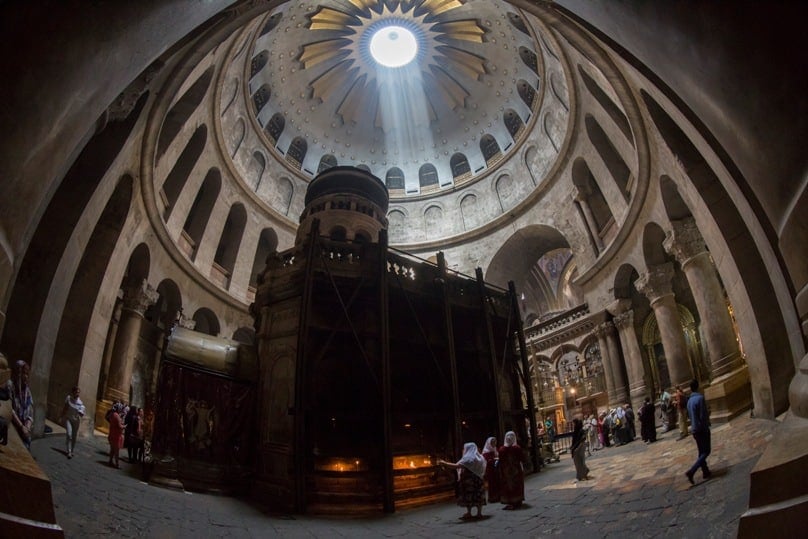
For the first time in 200 years, experts have begun a restoration of the Edicule of the Tomb in the Church of the Holy Sepulchre, where, according to Christian tradition, Jesus was laid to rest after his crucifixion.
The project, which began in early June, is expected to take up to one year to complete and will include sorely needed damage repair and reinforcement of the structure.
The work is being carried out by experts from the National Technical University of Athens.
The project came together when the three principal churches overseeing the tomb under the 19th-century Status Quo agreement overcame enduring differences in a place where rights over every section of the church has been jealously guarded for centuries.
The Status Quo agreement was put in place by the Ottoman rulers in 1852 and preserved the division of ownership and responsibilities of the various Christian holy sites. At the Church of the Holy Sepulchre, it governs the responsibilities of the principal churches – Greek Orthodox, Roman Catholic, Armenian Apostolic – as well as the Ethiopian, Syriac and Coptic churches.
“There wasn’t any friction on this issue,” said Franciscan Fr Athanasius Macora, who is responsible for supervising the agreement on the part of the Franciscan Custody of the Holy Land. “There was good chemistry between the three heads of the churches and they agreed to it right away.”
However, the term “right away” is relative as the heads of the principal churches first brought up the issue of a very conservative “consolidation” of the edicule in 2000.
The current Edicule of the Tomb was built by the Greek Orthodox community in 1810, two years after a devastating fire. It has been encased in metal scaffolding since the British Mandate period in the mid-20th century because of concern for its stability.
Though many church-connected professionals have expressed concern over the structure since 2000, it took the shutting down of the tomb for four hours by the Israeli Police in February 2015 because of safety concerns – a blatant violation of the Status Quo agreement – to get the churches to act on their earlier discussions. An agreement to carry out the work on the tomb was signed in March.
“The idea is to strengthen the structure and try to bring to get it back to its pristine state,” Father Macora said. “It is important that the work goes well. If all goes well, it will enhance the relationship (among the churches). If it doesn’t go well, it will not help their relationship.”
The tomb today is surrounded by a white perimeter wall, but the work on its exterior walls is taking place in the evening so pilgrims can continue to visit the interior of the tomb, he said.
All three churches are contributing to pay the $3.4 million price tag for the project. Jordanian King Abdullah also made a personal contribution for the restoration. Until 1967, the Old City of Jerusalem, where the Church of the Holy Sepulchre is located, was under Jordanian control and the king continues to play a role in the safe guarding of Christian and Muslim holy sites.
“The tomb is the heart of the shrine. It is the most important reason why people are coming to visit the church and … everyone knew the (the restoration) needed to be done,” Fr Macora said. “There is no reason it could not be done. It is important that the work be done in a way which respects the rights of other communities.”
He noted that despite the often-cited disputes among the churches, relations have improved since the 1960s and though they have reached a plateau since then, fewer conflicts emerge today.
“There have been sporadic outbreaks and there will be outbreaks in the future, but they are significantly less than in the past,” Fr Macora said.
Cleaning work has also been undertaken on some of the mosaics in the church and work remains to be done on the floor around the tomb, which cannot begin until the restoration of the tomb is complete, he said.
This is not the first time the three denominations came together for a restoration project. In 1997, they cooperated to restore and decorate the great dome above the tomb with the financial support of the late Catholic philanthropists George and Marie Doty, seemingly ushering in a new era of cooperation.
Three years ago in Bethlehem, restoration and renovation work also began at the Church of the Nativity with the Palestinian Authority given the role of intermediary between the churches. The wooden roof of the church has been repaired and work is underway on wall mosaics.
